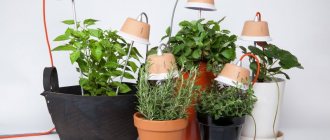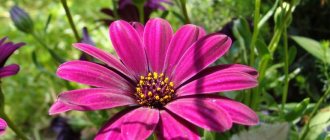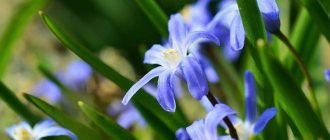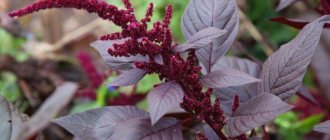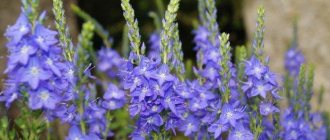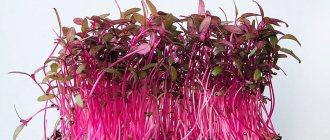The main advantages of these popular garden plants are their striking umbrella-shaped inflorescences and beautiful, often edged or very fragrant leaves. The flowers usually have five petals, of which the top two are often larger than the rest and have contrastingly colored veins. This extensive genus, with a natural range spanning Africa, Australia, the Middle East and Asia Minor, includes mainly subshrubs and herbaceous perennials, preferring open sunny locations and frost-free climates. Although only a few species are widely bred, they come in hundreds of different varieties.
Pelargonium
There are four main and many small groups of pelargoniums.
- Ivy-leaved pelargoniums - with small dense palmate leaves and drooping shoots - are ideal for hanging baskets.
- Royal (large-flowered, English) pelargoniums are distinguished by large bright corollas.
- Fragrant pelargoniums have pinnately incised leaves with a strong, pleasant aroma.
- The leaves of zonal pelargoniums are round, slightly lobed, with a wide contrasting border along the edge or at some distance from it. These pelargoniums are colloquially called geraniums, but should not be confused with plants of the genus Geranium.
There is an additional division of pelargonium varieties, which includes angelic pelargoniums with small two-tone flowers; star-shaped pelargoniums with appropriately shaped corollas; unique pelargoniums with large fragrant flowers. In addition, there are dwarf and miniature plants that are perfect for decorative vases and window boxes.
All pelargoniums can be grown in containers, but many are used as bedding annuals. Most bloom all summer and until early autumn, although the picturesque inflorescences of the royal varieties can only be admired for a few weeks in mid-summer.
Recommended species and varieties
P. acetosum (P. sour)
The flowers are pink-orange, up to 4 cm in diameter, with darker veins on the upper petals. They bloom in spring and summer. The leaves are glaucous, round, up to 4 cm in diameter, with a red serrated edge. The height and diameter of the plant is 60x60 cm.
Pink-orange flowers
P. “Amethyst” (ivy leaf)
On lashes up to 60 cm long, many bright compact umbrellas of purple semi-double flowers are formed. The leaves are round, crenate, up to 5 cm in diameter. Plant height and diameter -30x25 cm
Many bright compact umbrellas
“Apple Blossom Rosebud” (zonal)
The double flowers of this variety have greenish centers and white petals with pink edges. The umbrellas are compact, spherical, up to 15 cm in diameter. Rounded leaves up to 10 cm in diameter. This pelargonium is usually bred in pots. The height and diameter of the plant is 60x45 cm.
Greenish centers and white petals
P. “Atomic Snowflake” (fragrant)
The leaves are round, lobed, with a golden pattern and a lemon aroma. Purple flowers up to 2.5 cm in diameter are collected in loose umbels. The height and diameter of the plant is 45x30 cm.
Leaves are round, lobed
P. “Attar of Roses” (fragrant)
The leaves have a ruffled edge and smell like roses. Light pink flowers in loose umbels with a diameter of up to 10 cm. The height and diameter of the plant is 60x45 cm.
Leaves with ruffled edges
P. australe (P. southern)
Small star-shaped flowers bloom throughout most of the spring and summer. They are pale pink or white. The upper petals have dark pink veins. Spreading bushes with pubescent, slightly lobed, slightly fragrant leaves up to 10 cm in diameter. The height and diameter of the plant is 30x45 cm.
Small star-shaped flowers
P. “Bird Dancer” (stellate)
A dwarf bushy variety that produces masses of pink flowers with narrow, vaguely jagged petals along the edge. Great for flower beds and tubs. The height and diameter of the plant is 25x20 cm.
Dwarf bushy variety
“Caroline Schmidt” (zonal)
This flowerbed variety has leaves with a silvery-white edge. Bright red flowers in umbels with a diameter of up to 12.5 cm. The height and diameter of the plant is 25x20 cm.
Leaves with silvery-white edges
“Catford Belle” (angelic)
Semi-double pinkish-lilac flowers with a dark burgundy pattern are collected in dense umbrellas with a diameter of up to 10 cm. The leaves are green, deeply lobed. This compact pelargonium is well suited for window boxes. The height and diameter of the plant is 45x45 cm.
Stanley Padbury Stringer (1911-1986) was born in the small English town of Occold, England. He was a vicar and the pupils of Oakland School always remembered him with kind words, as he allowed them to play cricket on the lawn in front of his house. The Internet also mentions a funny incident that happened to Reverend Stringer during one of his Sunday sermons, when he discovered that instead of a sheet of paper with a sermon, he had taken with him a sheet with a list of pelargoniums. The people of Occold knew that their canon was developing new varieties of pelargonium in the vicarage greenhouse, but few of them realized how significant his contribution to this field was. His name and photographs of the pelargonium varieties he bred can be found on many websites in Europe, North America and Australia, and the varieties have been growing and blooming in the collections of lovers of these countries and in nurseries for decades. Its varieties are also well known here in Russia, although recently, in pursuit of new products, many collectors have removed old varieties from their collections, including the varieties of Stanley P. Stringer. Stringer turned his greenhouse into a kind of scientific laboratory. Growing different varieties to avoid accidental pollination, he isolated the flowering specimens with women's stockings. This approach prevented unwanted crossbreeding and indicated how seriously Stringer took hybridization. The breeder's fame came to him in 1964, when the first of his many miniatures, the Alde (Old) negovirina variety, was bred. It was not a double variety, but had five-petaled salmon-colored flowers and dark foliage.
In 1966-67, pelargoniums with double, ten-petalled flowers were bred; these are miniatures:
- Rigal (Rigal) with scarlet flowers and dark leaves;
- Denebola (Denebola) with purple-pink flowers with a white center;
- Orion , was abundantly covered with orange flowers and became a beautiful plant. This variety was important not only in itself, but also because, together with the ivy-leaved pelargonium Blue Peter, it gave rise to the famous subgroup of pelargoniums called Deacon.
Dickons were the result of unexpected success when crossing zonal double miniature with ivy-leaved pelargonium. This interspecific hybrid became the basis of the famous subgroup of Deacons, in the name of which he reflected his profession (Deacon - priest; deacon). Stringer's goal was to grow pelargoniums that were compact and bore many double flowers. And he succeeded. Stanley Stringer began experimenting with crossing ivy-leaved pelargoniums and miniatures in the early 60s. From these crosses he obtained a series of dwarfs with double flowers, which he called Deacons. Plants in this subgroup flower more profusely than other zonal pelargoniums and they branch very well, making them ideal show plants. Moreover, some of them are still present at exhibitions today. Stringer's collection of Deacon varieties includes a wide range of colors, from white and pink to orange and purple-red. Despite the fact that this group of varieties had ivy-leaved pelargoniums in their parents, they do not have features characteristic of ivy-leaved pelargoniums, but have a leaf typical of zonal pelargoniums, which is why they were classified as a group of zonal pelargoniums. All Deacons are considered dwarfs, although many can reach quite large sizes when grown in large pots. Their growth patterns also differ between varieties and can be adjusted by the size of the pot. Dickons are good compact potted plants with a large number of double flower caps. They bloom profusely in early spring, require regular feeding, and can be recommended for beginning amateur gardeners.
The first six varieties were bred in 1969-70, and were introduced in 1970 at the Chelsea Flower Show negovirina by Harold Bagust of Wyck Hill Nurseries. The varieties were Deacon Bonanza, Deacon Coral Reef, Deacon Fireball, Deacon Lilac Mist, Deacon Mandarin and Deacon Romance. The Deacon Lilac Mist variety was recognized as the best. This is a dwarf zonal pelargonium (Dwarf Zonal Pelargonium), with a large number of double flowers of pale pink color, which, as they bloom, change color to lilac, thickening over time. In the seventies, deacons were grown at Wyck Hill Nurseries, and when the oldest nursery ceased to exist, other nurseries took over the pelargoniums bred by Stringer. Stringer decided to finish the Deacon variety series by the end of 1979-80.
These varieties are: Deacon Bonanza , (Bringing good luck), 1969 Deacon Coral Reef (Coral Reef), 1969 Deacon Fireball (Ball Lightning), 1969 Deacon Mandarin (Mandarin) 1969 Deacon Lilac Mist (Lilac Mist) , 1970 Deacon Romance (Love Story), 1970 Deacon Arlon, 1972 Deacon Barbecue , (Barbecue), 1972 Deacon Minuet , (Minuet), 1972 Deacon Trousseau, (Dowry), 1972 Deacon Flamingo , 1973 Deacon Sundburst , 1973 Deacon Picotee , 1973 Deacon Constancy, 1977 Deacon Jubilant , 1977 Deacon Peacock , 1977 Deacon Birthday , 1978 Deacon Gala , 1978 Deacon Summertime , 1978 Deacon Regalia , 1978 Deacon Clarion , Loud 1979 Deacon Finale , 1979 Deacon Suntan , 1979 Deacon Monnlight , 1981 And three varieties with golden-green foliage, the result of a sport from the original Deacon varieties : Deacon Golden Bonanza with golden-green foliage Deacon Golden Gala with golden-green foliage Deacon Golden Lilac Mist with golden-green foliage 1978
With this last batch, Stanley Stringer decided to finish breeding new varieties of Deacons and focus on other types of pelargonium. In total, Stringer bred 27 varieties of Deacons. But Stringer never limited himself to breeding only Deacons. At the time Deacons became famous, he was working on Sun Rocket , the first of his variegated zonal pelargoniums with golden foliage and bright orange double flowers. This is a miniature variety, from the group “Fancy Leaf” negovirina (Fancy Leaves). I came across information that most likely most of its variegated varieties were obtained by crossing zonal pelargonium (P. Zonal) and species pelargonium (P. Fruterum). In honor of his hometown of Occold (England), Stanley Stringer named another wonderful variety series of his pelargoniums, consisting of 9 varieties bred in 1970-1980: Occold Embers (Occold Ember) (Dw/C) - zonal dwarf variegated pelargonium , 1977-84 Occold Lagoon (Occold Lagoon), (Dw/d) – zonal dwarf terry pelargonium, 1982 Occold Orange Tip (Occold's White Butterfly), (Min/d) – zonal miniature terry pelargonium Occold Profusion (Occold's Abundance), (Dw /d) – zonal dwarf terry pelargonium Occold Shield (Occold Shield), (Dw/C/d) – zonal dwarf variegated terry pelargon. 1984 Occold Tangerine (Z) - zonal pelargonium with a simple flower Occold Volcano (Occold Volcano). (Dw/C/d) – zonal dwarf variegated terry pelargonium 1984 Occold Surprise , Occold Ruby,
The most famous and beautiful variety is considered Occold Shield. This variety has bronze-gold foliage with a distinctive brown zone in the center and semi-double orange-red flowers. In 2014, the magnificent pelargonium Occold Shield negovirina, with its double bright red-orange flowers and golden-green leaves with a bronze spot in the center of the leaf, from which it takes its name, was presented by Fibrex Nurseries at the Chelsea Flower Show ( Chelsea Flower Show), where she received a well-deserved award - a gold medal. The Occold Embers and Occold Volcano varieties also have beautiful zones or spots on the golden leaves. The Occold pelargonium series is well suited for window boxes and containers, in sun and partial shade. All these pelargoniums are still available for sale and some of them can be seen blooming luxuriantly in the vicinity of the village of Ockold.
Later, when Stringer retired and moved to Debenham negovirina, he continued to work on his favorite miniature varieties and developed pelargoniums with speckled flowers. In 1984, the varieties Gemma (Gemma) and Magda (Magda) appeared. Magda has a densely double flower, large, with pink petals with specks, dashes and red sectors. The reverse side of the petal is almost white and also with red strokes. One of the last varieties Stringer developed was the miniature Golden Chalice . Sometimes you can find the names Sussex Chalice (Sussex Chalice), or Sussex Chance (Sussex Luck). This variegated variety has olive-green leaves with a creamy edge, and salmon-colored flowers, often with scarlet spots. Looks great. Stanley Stringer died in 1986 at the age of 75, leaving behind about 160 varieties of pelargonium. He made an enormous contribution to the breeding of pelargoniums, but his recognition came mainly when his life came to an end.
Growing
Keep container pelargoniums in 15 cm diameter pots with good drainage in a frost-free location in the sun.
Water abundantly in summer, sparingly in winter. Replant in the spring, approximately every 2 years. Remove spent flowers and leaves regularly.
Plant flowerbed pelargoniums in fertile, well-drained soil with a neutral or alkaline reaction when the threat of return frosts has passed, and dig up before the first frosts in the fall. Renew your planting annually. Treat ivy-leaved varieties in hanging baskets in the same way.
Deacons
Varieties similar to dwarf ones, with numerous double flowers. Their names always contain the word Deacon, often abbreviated as D.
Bred by the English priest Stanley P. Stringer (1911-1986) by crossing the zonal miniature pelargonium Orion with the ivy-leaved pelargonium Blue Peter. This interspecific hybrid became the basis of the Deacon subgroup (Deacon - priest; deacon).
- Deacon Regalia is a rather old variety (1978) with scarlet double flowers in spherical inflorescences. Leaves with a barely noticeable zone.
Pelargonium zonal double dwarf Deacon Regalia
Rosaceae (Rosebud or Noisette)
Rosebuds are hybrids with double, half-opened flowers that do not open fully. They have numerous petals collected in the form of a rose bud.
- Denis is a compact variety reminiscent of the famous Appleblossom Rosebud variety. It is distinguished by a purer pink color of the buds, without a green tint. The flowers are double, soft pink, the edges of the petals are a deeper pink color. The leaves are silvery-green, with a blurred dark zone along the edge.
- Noel Gordon is a dwarf double variety with dense large inflorescences of pink flowers. Leaves with dark zone.
- Pink Rambler – double two-color rosebud-pelargonium. The petals are coral red on the inside and white on the outside. The leaves have a dark zone.
|
|
|
Tulip Pelargonium (Tulip Flowered)
There is a very small group of varieties whose flowers remain almost closed in the inflorescence, resembling a semi-double tulip. The variety "Patricia Andrea" with pink flowers, isolated as a sport from the variety "Fiat" by American flower growers named Andrea, was the first variety of this group. Tulip pelargoniums are often included in the group of double zonal pelargoniums.
Pelargonium tulip Patricia Andrea

